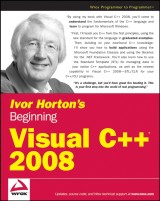Details

Ivor Horton's Beginning Visual C++ 2008
1. Aufl.
|
33,99 € |
|
| Verlag: | Wiley |
| Format: | EPUB |
| Veröffentl.: | 26.08.2011 |
| ISBN/EAN: | 9780470428313 |
| Sprache: | englisch |
| Anzahl Seiten: | 1392 |
DRM-geschütztes eBook, Sie benötigen z.B. Adobe Digital Editions und eine Adobe ID zum Lesen.
Beschreibungen
Proudly presenting the latest edition of one of the all-time bestselling books on the C++ language, successful author Ivor Horton repeats the formula that has made each previous edition so popular by teaching you both the standard C++ language and C++/CLI as well as Visual C++ 2008. Thoroughly updated for the 2008 release, this book shows you how to build real-world applications using Visual C++ and guides you through the ins and outs of C++ development. With this book by your side, you are well on your way to becoming a successful C++ programmer.
Acknowledgments. <p>Introduction.</p> <p>Chapter 1: Programming with Visual C++ 2008.</p> <p>Chapter 2: Data, Variables, and Calculations.</p> <p>Chapter 3: Decisions and Loops.</p> <p>Chapter 4: Arrays, Strings, and Pointers.</p> <p>Chapter 5: Introducing Structure into Your Programs.</p> <p>Chapter 6: More about Program Structure.</p> <p>Chapter 7: Defining Your Own Data Types.</p> <p>Chapter 8: More on Classes.</p> <p>Chapter 9: Class Inheritance and Virtual Functions.</p> <p>Chapter 10: The Standard Template Library.</p> <p>Chapter 11: Debugging Techniques.</p> <p>Chapter 12: Windows Programming Concepts.</p> <p>Chapter 13: Windows Programming with the Microsoft Foundation Classes.</p> <p>Chapter 14: Working with Menus and Toolbars.</p> <p>Chapter 15: Drawing in a Window.</p> <p>Chapter 16: Creating the Document and Improving the View.</p> <p>Chapter 17: Working with Dialogs and Controls.</p> <p>Chapter 18: Storing and Printing Documents.</p> <p>Chapter 19: Writing Your Own DLLs.</p> <p>Chapter 20: Connecting to Data Sources.</p> <p>Chapter 21: Updating Data Sources.</p> <p>Chapter 22: More on Windows Forms Applications.</p> <p>Chapter 23: Accessing Data Sources in a Windows Forms Application.</p> <p>Appendix A: C++ Keywords.</p> <p>Appendix B: ASCII Codes.</p> <p>Appendix C: Windows Message Types.</p> <p>Index.</p>
<b>Ivor Horton</b> graduated as a mathematician and was lured into information technology by promises of great rewards for very little work. In spite of the reality being usually a great deal of work for relatively modest rewards, he has continued to work with computers to the present day. He has been engaged at various times in programming, systems design, consultancy, and the management of the implementation of projects of considerable complexity.<br /> Horton has many years of experience in the design and implementation of computer systems applied to engineering design and to manufacturing operations in a variety of industries. He has considerable experience developing occasionally useful applications in a wide variety of programming languages, and teaching primarily scientists and engineers to do likewise. He has been writing books on programming for more than 10 years now, and his currently published works include tutorials on C, C++, and Java. At the present time, when he is not writing programming books or providing advice to others, he spends his time fishing, traveling, and trying to speak better French.
<b>Ivor Horton's Beginning Visual C++ 2008</b> <p>Proudly presenting the latest edition of one of the all-time bestselling books on the C++ language, successful author Ivor Horton repeats the formula that has made each previous edition so popular by teaching you both the standard C++ language and C++/CLI as well as Visual C++ 2008. Thoroughly updated for the 2008 release, this book shows you how to build real-world applications using Visual C++ and guides you through the ins and outs of C++ development.</p> <p>Horton's accessible approach and detailed examples cover both flavors of the C++ language—native ISO/ANSIC++ Windows application development using the Microsoft Foundation Classes (MFC), as well as the development of C++/CLI Windows applications using Windows Forms. He also introduces you to the techniques you can use for accessing data sources in both MFC and Windows Forms, and working examples demonstrate each programming technique that is being discussed. With this book by your side, you are well on your way to becoming a successful C++ programmer.</p> <p><b>What you will learn from this book</b></p> <ul> <li> <p>How to use the Standard Template Library, a powerful and extensive set of tools for organizing and manipulating data in your native C++ programs</p> </li> <li> <p>Techniques for finding errors in your C++ programs</p> </li> <li> <p>The ways that Microsoft® Windows® applications are structured and the elements that are essential for each application</p> </li> <li> <p>How to create and use common controls in order to build the graphical user interface for your application</p> </li> <li> <p>Ways to develop your own libraries using MFC</p> </li> <li> <p>The different controls that are available for accessing data sources, how they work, and how to customize them</p> </li> </ul> <p><b>Who this book is for</b><br /> This book is for anyone who wants to write C++ applications for the Microsoft Windows OS. No prior experience of any programming language is assumed.</p> <p><b>Wrox Beginning guides</b> are crafted to make learning programming languages and technologies easier than you think, providing a structured, tutorial format that will guide you through all the techniques involved.</p>
Diese Produkte könnten Sie auch interessieren:

Pattern-Oriented Software Architecture, Patterns for Resource Management

von: Michael Kircher, Prashant Jain

33,99 €















